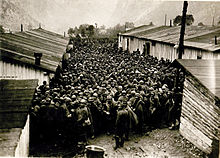Prisoners of war in World War I
[1][2] 25–31% of Russian losses (as a proportion of those captured, wounded, or killed) were to prisoner status, for Austria-Hungary 32%, for Italy 26%, for France 12%, for Germany 9%; for Britain 7%.
[3] All nations pledged to follow the Hague Conventions on fair treatment of prisoners of war, and the survival rate for POWs was generally, though not always, much higher than that of combatants at the front.
[10] The conditions of the POW camps were, in general, satisfactory (and much better than in World War II[2]), thanks in part to the efforts of the International Red Cross and inspections by neutral nations.
While those put to work in agriculture fared well, other forms of work were dangerous to POWs, such as the digging of the Rove tunnel near the Étang de Berre in France, the demining of battlefields in France in 1919, comparable to those of the Russian gulag on the construction site of the railway line from Petrograd to Murmansk.
[16] Article 7 of the Hague Convention provides for "treatment of prisoners in terms of food, clothing and bedding equivalent to that of the troops of the government which captured them".
The prisoners of the Central Powers affected by the Allied blockade (Germany and Austria-Hungary) suffered from hunger like the rest of the population.
The prisoners were struck by epidemics, typhus and cholera, especially at the start of the war, a period of unpreparedness for the unexpected influx into Russia and Germany.
The humid forts requisitioned to serve as places of detention led to numerous cases of pulmonary illness.
Camps were established in the countryside as well as near the towns, which had consequences when epidemics of cholera or typhus threatened to spread to the civilian population.
[23] Some 11,800 British Empire soldiers, most of them Indians, became prisoners after the siege of Kut in Mesopotamia in April 1916; 4,250 died in captivity.
[24] Although many were in a poor condition when captured, Ottoman officers forced them to march 1,100 kilometres (684 mi) to Anatolia.
This lack of reciprocity is a violation of Article 20 of the Hague Convention of 1899, which reads: "After the conclusion of peace, the repatriation of prisoners of war shall be carried out as quickly as possible".



